By HarmonTupper '29. Boston: Little, Brown & Co.,1965. 536 pp. $8.95.
Soon after the builders of the Trans-Siberian Railroad had constructed the first tunnel east of the Urals by roofing over a deep cutting in the Yablonovy Range, an inscription was placed above the tunnel's western entrance, reading: "To the Great Ocean." Mr. Tupper has taken it for the title of his book on Siberia and the building of what was originally called the "Great Siberian Railway," "still the longest continuous railway on earth." It is a grand subject and he handles it on a grand scale. The beautifully written book is crowded with events and characters, embellished with well over a hundred photographs from many sources, some taken by the author himself, and solidly supported by a bibliography covering more than 22 pages and nine pages of acknowledgments. What must have been a labor of love has produced a fine piece of work.
Almost without exception the engineers who built sections of the railroad had to cope with shortages of labor and building materials, primitive conditions, vast distances, poor communications, and appalling natural obstacles. In western Siberia it was only possible to work four months out of the year and in mid-Siberia a mere three months. The Khabarovsk-Vladivostok division was built by 15,000 Chinese coolies, who feared rain and tigers, and did not know how to use shovels and wheel barrows. As for the famous short-cut to Vladivostok through Manchuria, the "Chinese Eastern Railway," the author justly observes: "Other engineers throughout the world have contended with deserts and mountain ranges, arctic cold, rampaging floods, pestilence, bandits, saboteurs, and obstructive officials without number, but [Chief Engineer] Yugovich and his associates were perhaps unique in that they coped with all of these formidable impediments almost simultaneously." Last of all, hardest to build, and most expensive in cost per mile was the 162-mile loop around "Old Man Baikal," the redoubtable lake whose beauties and peculiarities are allotted, and deserve, a whole chapter.
About three-quarters of the book deal with the Siberian background, the construction of the Trans-Siberian railroad and the sweeping changes it helped bring about throughout Siberia down to the revolutions of 1917. The last quarter carries the history of the great road down to the present, and the reader shares Mr. Tupper's final judgment that "no other single transcontinental railway has ever done so much for so many."
Professor of History
 View Full Issue
View Full Issue
More From This Issue
-
 Feature
FeatureThe Antileadership Vaccine
February 1966 By JOHN W. GARDNER -
 Feature
FeatureThe Computer at Dartmouth
February 1966 By John G. Kemeny -
 Feature
FeatureAlumni College Topics Set
February 1966 -
 Feature
FeatureMore Honors for Good Teaching
February 1966 -
 Article
ArticleThe Undergraduate Chair
February 1966 By LARRY GEIGER '66 -
 Class Notes
Class Notes1914
February 1966 By ELMER ROBINSON, CHARLES S. BATCHELDER, MARTIN J. REMSEN
JOHN C. ADAMS
Books
-
 Books
BooksShelf life
Jan/Feb 2012 -
 Books
BooksEUGEN ROSENSTOCK-HUESSY: BIBLIOGRAPHY-BIOGRAPHY.
December 1959 By ALEXANDER LAING '25 -
 BOOKS
BOOKSIcon in the Family
MAY | JUNE 2021 By Elizabeth Janowski ’21 -
 Books
BooksEURIPIDES II.
July 1956 By JOHN B. STEARNS '16 -
 Books
BooksEavesdropping
December 1975 By THOMAS S. SCOTT-CRAIG -
 Books
BooksNative Wood-notes
JUNE 1983 By Wilfrid Mellers


